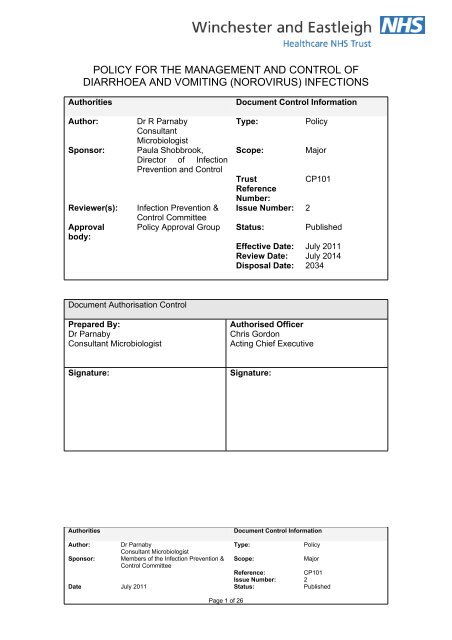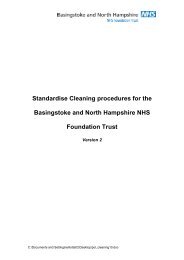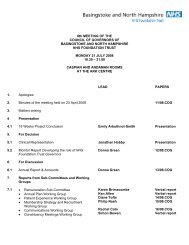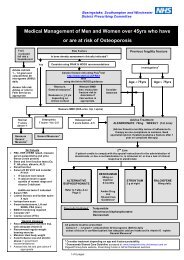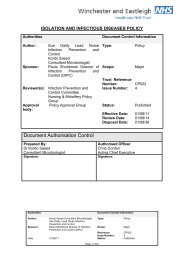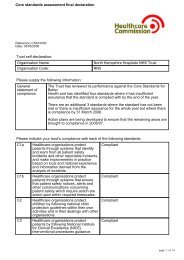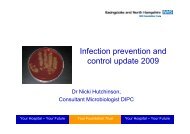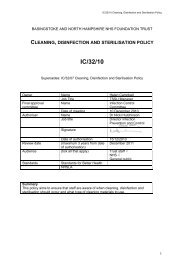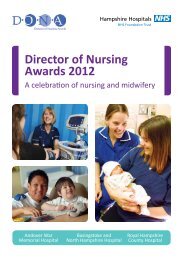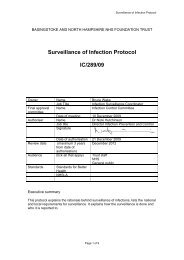Policy for the management and control of diarrhoea and vomiting
Policy for the management and control of diarrhoea and vomiting
Policy for the management and control of diarrhoea and vomiting
Create successful ePaper yourself
Turn your PDF publications into a flip-book with our unique Google optimized e-Paper software.
POLICY FOR THE MANAGEMENT AND CONTROL OF<br />
DIARRHOEA AND VOMITING (NOROVIRUS) INFECTIONS<br />
Authorities<br />
Author:<br />
Sponsor:<br />
Reviewer(s):<br />
Approval<br />
body:<br />
Dr R Parnaby<br />
Consultant<br />
Microbiologist<br />
Paula Shobbrook,<br />
Director <strong>of</strong> Infection<br />
Prevention <strong>and</strong> Control<br />
Document Control In<strong>for</strong>mation<br />
Type:<br />
Scope:<br />
<strong>Policy</strong><br />
Major<br />
Trust<br />
CP101<br />
Reference<br />
Number:<br />
Issue Number: 2<br />
Infection Prevention &<br />
Control Committee<br />
<strong>Policy</strong> Approval Group Status: Published<br />
Effective Date: July 2011<br />
Review Date: July 2014<br />
Disposal Date: 2034<br />
Document Authorisation Control<br />
Prepared By:<br />
Dr Parnaby<br />
Consultant Microbiologist<br />
Authorised Officer<br />
Chris Gordon<br />
Acting Chief Executive<br />
Signature:<br />
Signature:<br />
Authorities<br />
Document Control In<strong>for</strong>mation<br />
Author:<br />
Dr Parnaby<br />
Type:<br />
<strong>Policy</strong><br />
Consultant Microbiologist<br />
Sponsor: Members <strong>of</strong> <strong>the</strong> Infection Prevention & Scope:<br />
Major<br />
Control Committee<br />
Reference:<br />
CP101<br />
Issue Number: 2<br />
Date July 2011 Status: Published<br />
Page 1 <strong>of</strong> 26
Winchester & Eastleigh Healthcare NHS Trust<br />
POLICY FOR THE MANAGEMENT AND CONTROL OF<br />
DIARRHOEA AND VOMITING (NOROVIRUS) INFECTIONS<br />
DOCUMENT CONTROL<br />
Document Amendments<br />
Number Details By Whom Date<br />
1 Re<strong>for</strong>matted into Trust <strong>for</strong>mat to meet NHSLA<br />
st<strong>and</strong>ards with added notes to training,<br />
compliance, Trust policy references, <strong>and</strong> roles<br />
Steven Jennings<br />
Divisional<br />
Governance Lead<br />
2 3 yearly review IPC Team (lead<br />
author Sue Dailly)<br />
6 June<br />
2008<br />
February<br />
2011<br />
Review Timetable<br />
Date Reason By Whom Date<br />
Completed<br />
2011 3 year review Sue Dailly Lead July 2011<br />
Nurse Infection<br />
Prevention &<br />
Control Team<br />
2014 3 year review IPC team<br />
Distribution List<br />
No Title<br />
1 All employees via <strong>the</strong> Winchester <strong>and</strong> Eastleigh Healthcare NHS<br />
Trust Intranet<br />
2 The public via Winchester <strong>and</strong> Eastleigh Healthcare NHS Trust<br />
Website<br />
RELATED TRUST POLICIES<br />
OP001 <strong>Policy</strong> <strong>for</strong> Management <strong>of</strong> Controlled Documents<br />
CP073 H<strong>and</strong> hygiene <strong>Policy</strong><br />
CP008 Incident Management & Reporting <strong>Policy</strong> Including <strong>the</strong> Management<br />
<strong>of</strong> Serious Untoward Incidents<br />
CP076 <strong>Policy</strong> <strong>for</strong> <strong>the</strong> St<strong>and</strong>ard Precautions <strong>and</strong> PPE (Personal Protection<br />
Equipment)<br />
CP030 Overarching Decontamination <strong>Policy</strong><br />
CP077 - <strong>Policy</strong> <strong>for</strong> Ward Closure due to an Infection Control Issue<br />
Authorities<br />
Document Control In<strong>for</strong>mation<br />
Author:<br />
Dr Parnaby<br />
Type:<br />
<strong>Policy</strong><br />
Consultant Microbiologist<br />
Sponsor: Members <strong>of</strong> <strong>the</strong> Infection Prevention & Scope:<br />
Major<br />
Control Committee<br />
Reference:<br />
CP101<br />
Issue Number: 2<br />
Date July 2011 Status: Published<br />
Page 2 <strong>of</strong> 26
Winchester & Eastleigh Healthcare NHS Trust<br />
POLICY FOR THE MANAGEMENT AND CONTROL OF<br />
DIARRHOEA AND VOMITING (NOROVIRUS) INFECTIONS<br />
CP021 Surveillance <strong>Policy</strong> (includes reporting <strong>of</strong> healthcare associated<br />
infections to <strong>the</strong> Health Protection agency)<br />
CP033 (NP 14) <strong>Policy</strong> <strong>for</strong> St<strong>and</strong>ards <strong>for</strong> Record Keeping by Nurses <strong>and</strong><br />
Midwives<br />
CP071 Major Outbreak Plan<br />
CP022 Isolation <strong>and</strong> Infectious Diseases <strong>Policy</strong><br />
Authorities<br />
Document Control In<strong>for</strong>mation<br />
Author:<br />
Dr Parnaby<br />
Type:<br />
<strong>Policy</strong><br />
Consultant Microbiologist<br />
Sponsor: Members <strong>of</strong> <strong>the</strong> Infection Prevention & Scope:<br />
Major<br />
Control Committee<br />
Reference:<br />
CP101<br />
Issue Number: 2<br />
Date July 2011 Status: Published<br />
Page 3 <strong>of</strong> 26
Winchester & Eastleigh Healthcare NHS Trust<br />
POLICY FOR THE MANAGEMENT AND CONTROL OF<br />
DIARRHOEA AND VOMITING (NOROVIRUS) INFECTIONS<br />
Contents<br />
Section Title Page<br />
1 Purpose 5<br />
2 Scope 5<br />
3 Roles <strong>and</strong> Responsibilities 5<br />
4 Introduction 6<br />
5 Signs <strong>and</strong> Symptoms 7<br />
6 Transmission 7<br />
7 Diagnosis 7<br />
8 Patient Management <strong>and</strong> Treatment 8<br />
9 Documentation 9<br />
10 Stool Samples 10<br />
11 Isolation 11<br />
12 H<strong>and</strong> hygiene 12<br />
13 Personal Protective Clothing 12<br />
14 Movement <strong>of</strong> Affected Patients 12<br />
15 Environmental cleaning 14<br />
16 Visitors 14<br />
17 Staff 15<br />
18 Ward Closure 16<br />
19 Outbreak Control Group 16<br />
20 Monitoring Compliance <strong>and</strong> Effectiveness 17<br />
21 Major Outbreak Control 17<br />
22 Training Implications 18<br />
23 References 18<br />
Appendix 1 Diarrhoea & Vomiting Action Plan <strong>for</strong> Wards 19<br />
Appendix 2<br />
NHS South Central Top 10 tips to help prevent<br />
outbreaks <strong>of</strong> Norovirus<br />
21<br />
Appendix 3 Equality Impact Assessment Tool 26<br />
Authorities<br />
Document Control In<strong>for</strong>mation<br />
Author:<br />
Dr Parnaby<br />
Type:<br />
<strong>Policy</strong><br />
Consultant Microbiologist<br />
Sponsor: Members <strong>of</strong> <strong>the</strong> Infection Prevention & Scope:<br />
Major<br />
Control Committee<br />
Reference:<br />
CP101<br />
Issue Number: 2<br />
Date July 2011 Status: Published<br />
Page 4 <strong>of</strong> 26
Winchester & Eastleigh Healthcare NHS Trust<br />
POLICY FOR THE MANAGEMENT AND CONTROL OF DIARRHOEA AND<br />
VOMITING (NOROVIRUS) INFECTIONS<br />
1 PURPOSE<br />
1.1 This policy has been developed to provide a practical document to equip all<br />
healthcare staff at Winchester & Eastleigh Healthcare NHS Trust (WEHCT)<br />
with <strong>the</strong> necessary in<strong>for</strong>mation on <strong>the</strong> recognition, <strong>management</strong> <strong>and</strong><br />
treatment <strong>of</strong> outbreaks <strong>of</strong> <strong>diarrhoea</strong> <strong>and</strong> <strong>vomiting</strong> such as Norovirus.<br />
2 SCOPE<br />
2.1 This policy extends to cover all WEHCT NHS Trust staff. This policy will also<br />
apply to honorary contract holders <strong>and</strong> staff employed by o<strong>the</strong>r organisations<br />
who work with <strong>the</strong> WEHCT NHS Trust patients <strong>and</strong> <strong>for</strong> <strong>the</strong> Trusts’ o<strong>the</strong>r staff.<br />
2.2 This policy complements pr<strong>of</strong>essional <strong>and</strong> ethical guidelines <strong>and</strong> <strong>the</strong> Nursing<br />
<strong>and</strong> Midwifery Council (NMC) Code <strong>of</strong> Pr<strong>of</strong>essional Conduct (NMC 2009).<br />
2.3 Infection prevention <strong>and</strong> <strong>control</strong> is <strong>the</strong> responsibility <strong>of</strong> ALL staff associated<br />
with patient care. A high st<strong>and</strong>ard <strong>of</strong> infection prevention <strong>and</strong> <strong>control</strong> is<br />
required on ALL wards <strong>and</strong> units, although <strong>the</strong> level <strong>of</strong> risk may vary. It is an<br />
important part <strong>of</strong> total patient care.<br />
2.4 It is essential that infection prevention <strong>and</strong> <strong>control</strong> is seen as an<br />
organisational responsibility <strong>and</strong> priority, that adequate isolation facilities <strong>and</strong><br />
resources are provided, <strong>and</strong> that appropriate infection <strong>control</strong> staff <strong>and</strong><br />
support services are available.<br />
2.5 This policy is ratified in line with OP001 Trusts <strong>Policy</strong> <strong>for</strong> <strong>the</strong> Management <strong>of</strong><br />
Controlled Documents (2007).<br />
3 ROLES AND RESPONSIBILITIES<br />
3.1 The Chief Executive (CEO) has overall responsibility <strong>for</strong> ensuring <strong>the</strong> Trust<br />
has appropriate strategies, policies <strong>and</strong> procedures in place to ensure <strong>the</strong><br />
Trust continues to work to best practice <strong>and</strong> complies with all legislation. The<br />
CEO has overall responsibility <strong>for</strong> <strong>the</strong> provision <strong>of</strong> adequate funding to meet<br />
<strong>the</strong> increased costs <strong>of</strong> outbreaks <strong>of</strong> Norovirus <strong>and</strong> adequate isolation facilities<br />
to enable national guidance on <strong>the</strong> <strong>control</strong> <strong>of</strong> Noroviruses to be implemented.<br />
3.2 Line managers<br />
3.3 Are responsible <strong>for</strong> ensuring this policy is accessible <strong>for</strong> all staff <strong>and</strong> that <strong>the</strong>y<br />
have read <strong>and</strong> understood <strong>the</strong> content. Line mangers are responsible <strong>for</strong><br />
ensuring any changes in practice are implemented, <strong>and</strong> any fur<strong>the</strong>r training<br />
needs identified <strong>and</strong> addressed. Ward managers are to assist with <strong>the</strong> root<br />
Authorities<br />
Document Control In<strong>for</strong>mation<br />
Author:<br />
Dr Parnaby<br />
Type:<br />
<strong>Policy</strong><br />
Consultant Microbiologist<br />
Sponsor: Members <strong>of</strong> <strong>the</strong> Infection Prevention & Scope:<br />
Major<br />
Control Committee<br />
Reference:<br />
CP101<br />
Issue Number: 2<br />
Date July 2011 Status: Published<br />
Page 5 <strong>of</strong> 26
Winchester & Eastleigh Healthcare NHS Trust<br />
POLICY FOR THE MANAGEMENT AND CONTROL OF DIARRHOEA<br />
AND VOMITING (NOROVIRUS) INFECTIONS<br />
cause analysis which will be carried out following a ward closure or death due<br />
to Norovirus (see section 20.4).<br />
3.4 All staff<br />
3.5 All staff must ensure that <strong>the</strong>ir practice follows <strong>the</strong> current policies.<br />
In<strong>for</strong>mation regarding <strong>the</strong> failure to comply with <strong>the</strong> policy (e.g. lack <strong>of</strong><br />
training, inadequate equipment) must be reported to <strong>the</strong> line manger <strong>and</strong> <strong>the</strong><br />
incident reporting system used where appropriate.<br />
3.6 Infection Prevention & Control Team (IPC team)<br />
3.7 The Infection Prevention & Control Team (IPCT) have a responsibility to <strong>of</strong>fer<br />
advice to healthcare staff on treatment <strong>and</strong> isolation requirements. The team<br />
will collate data <strong>and</strong> share this within <strong>the</strong> Trust via <strong>the</strong> Infection Prevention &<br />
Control Committee (IPCC) <strong>and</strong> <strong>the</strong> Infection Prevention & Control divisional<br />
leads <strong>and</strong> link practitioners (IPCLPs).<br />
4 INTRODUCTION<br />
4.1 Small round structured viruses (SRSVs e.g. norovirus), are <strong>the</strong> most common<br />
cause <strong>of</strong> outbreaks <strong>of</strong> gastro-enteritis in hospitals <strong>and</strong> can also cause<br />
outbreaks in o<strong>the</strong>r settings such as schools, nursing homes <strong>and</strong> cruise ships.<br />
Hospital outbreaks <strong>of</strong>ten lead to ward closure <strong>and</strong> major disruption in hospital<br />
activity. Outbreaks can affect both patients <strong>and</strong> staff, sometimes with attack<br />
rates in excess <strong>of</strong> 50%. For this reason, staff shortages can be severe,<br />
particularly if several wards are involved at <strong>the</strong> same time.<br />
4.2 The disease was historically known as <strong>the</strong> “winter <strong>vomiting</strong> disease” due to its<br />
seasonality <strong>and</strong> typical symptoms. However in recent years this typical<br />
pattern has changed <strong>and</strong> outbreaks have occurred throughout <strong>the</strong> year. In a<br />
recent study <strong>the</strong> Health Protection Agency (HPA), have showed that variants<br />
to <strong>the</strong> virus emerge frequently <strong>and</strong> become <strong>the</strong> predominant circulating strain<br />
which in turn is later replaced by a new variant. Large numbers <strong>of</strong> contacts<br />
can <strong>the</strong>re<strong>for</strong>e be affected as immunity to <strong>the</strong> illness is not long-lasting.<br />
4.3 Norovirus infections are usually associated with relatively mild <strong>and</strong> short lived<br />
symptoms <strong>and</strong> affected individuals in <strong>the</strong> community rarely seek medical<br />
attention. However outbreaks involving patients <strong>and</strong> staff in hospitals can<br />
have a significant impact on hospital activities ranging from ward closures<br />
<strong>and</strong> delays in <strong>the</strong> admission <strong>and</strong> discharge <strong>of</strong> patients. It is <strong>the</strong>re<strong>for</strong>e<br />
essential that cases are detected early <strong>and</strong> isolated appropriately to prevent<br />
spread <strong>and</strong> major outbreaks. These viruses are relatively resistant to alcohol<br />
gel so soap <strong>and</strong> water must be used when washing h<strong>and</strong>s.<br />
Authorities<br />
Document Control In<strong>for</strong>mation<br />
Author:<br />
Dr Parnaby<br />
Type:<br />
<strong>Policy</strong><br />
Consultant Microbiologist<br />
Sponsor: Members <strong>of</strong> <strong>the</strong> Infection Prevention & Scope:<br />
Major<br />
Control Committee<br />
Reference:<br />
CP101<br />
Issue Number: 2<br />
Date July 2011 Status: Published<br />
Page 6 <strong>of</strong> 26
Winchester & Eastleigh Healthcare NHS Trust<br />
POLICY FOR THE MANAGEMENT AND CONTROL OF DIARRHOEA<br />
AND VOMITING (NOROVIRUS) INFECTIONS<br />
5 SIGNS AND SYMPTOMS<br />
5.1 The average incubation period <strong>for</strong> norovirus associated gastro-enteritis is 12-<br />
48 hours. Patients cared <strong>for</strong> in bays where o<strong>the</strong>r patients have symptomatic<br />
Norovirus may have an extended incubation period <strong>and</strong> develop symptoms<br />
after 48 hours <strong>of</strong> contact with a source <strong>of</strong> <strong>the</strong> virus.<br />
5.2 The illness is characterized by a sudden acute onset <strong>of</strong>:<br />
<br />
<br />
<br />
Vomiting (may be projectile)<br />
Watery <strong>diarrhoea</strong> <strong>and</strong> abdominal cramps<br />
Nausea<br />
5.3 In addition headache, myalgia, fever <strong>and</strong> malaise are common. Some or all <strong>of</strong><br />
<strong>the</strong> above symptoms may be present.<br />
5.4 Symptoms last between one <strong>and</strong> three days <strong>and</strong> recovery is usually rapid.<br />
The frequency <strong>of</strong> <strong>the</strong> symptoms can vary with some patients having just 2-3<br />
episodes <strong>of</strong> <strong>diarrhoea</strong> or <strong>vomiting</strong>, ra<strong>the</strong>r than <strong>the</strong> expected frequent<br />
episodes, this depend on <strong>the</strong> circulating virus at <strong>the</strong> time <strong>of</strong> <strong>the</strong> outbreak. In<br />
some cases <strong>the</strong> duration <strong>of</strong> symptoms may be longer.<br />
5.5 Dehydration is <strong>the</strong> most common complication <strong>and</strong> patients may require<br />
replacement fluids.<br />
6 TRANSMISSION<br />
6.1 Noroviruses are highly contagious with as few as 10 -100 virus particles<br />
thought to be sufficient to cause infection. Noroviruses are transmitted<br />
primarily through <strong>the</strong> faecal –oral route ei<strong>the</strong>r by person to person spread or<br />
via contaminated food or water. In addition noroviruses can be spread via<br />
aerosol dissemination <strong>of</strong> infected particles following <strong>vomiting</strong>.<br />
6.2 Transmission can also occur through h<strong>and</strong> transfer <strong>of</strong> <strong>the</strong> virus to <strong>the</strong> oral<br />
mucosa following contact with environmental surfaces, fomites <strong>and</strong><br />
equipment which have been contaminated with ei<strong>the</strong>r faeces or vomit.<br />
7 DIAGNOSIS<br />
7.1 Diagnosis <strong>of</strong> norovirus infection can <strong>of</strong>ten be made on clinical grounds from<br />
<strong>the</strong>ir characteristic features. However <strong>the</strong> infection can also be confirmed<br />
following testing <strong>of</strong> a stool sample.<br />
7.2 When an outbreak is suspected, it is imperative to initiate infection prevention<br />
<strong>and</strong> <strong>control</strong> measures immediately without waiting <strong>for</strong> virological confirmation<br />
from stool testing.<br />
Authorities<br />
Document Control In<strong>for</strong>mation<br />
Author:<br />
Dr Parnaby<br />
Type:<br />
<strong>Policy</strong><br />
Consultant Microbiologist<br />
Sponsor: Members <strong>of</strong> <strong>the</strong> Infection Prevention & Scope:<br />
Major<br />
Control Committee<br />
Reference:<br />
CP101<br />
Issue Number: 2<br />
Date July 2011 Status: Published<br />
Page 7 <strong>of</strong> 26
Winchester & Eastleigh Healthcare NHS Trust<br />
POLICY FOR THE MANAGEMENT AND CONTROL OF DIARRHOEA<br />
AND VOMITING (NOROVIRUS) INFECTIONS<br />
8 PATIENT MANAGEMENT AND TREATMENT<br />
8.1 Treatment<br />
8.2 Currently <strong>the</strong>re is no effective antiviral treatment <strong>for</strong> noroviruses. It is a self<br />
limiting illness which will usually cease within a few days. It is important to<br />
ensure prompt fluid replacement to prevent dehydration <strong>and</strong> its complications.<br />
8.3 There is a sample patient, relatives <strong>and</strong> carer’s in<strong>for</strong>mation leaflet available<br />
on <strong>the</strong> intranet, ref 308 “Norovirus”. Copies <strong>of</strong> this leaflet are available from <strong>the</strong><br />
IPC team.<br />
8.4 What to do if you suspect <strong>the</strong>re is an outbreak?<br />
8.5 If you have 2 or more cases <strong>of</strong> unexplained <strong>diarrhoea</strong> <strong>and</strong> / or <strong>vomiting</strong><br />
or nausea on your ward, ei<strong>the</strong>r staff or patients, you may be at <strong>the</strong> start <strong>of</strong> an<br />
outbreak. It is <strong>the</strong> responsibility <strong>of</strong> <strong>the</strong> nurse in charge to contact <strong>the</strong> Infection<br />
Prevention & Control Team (IPC Team) on ext 4483 or 5170 immediately <strong>for</strong><br />
fur<strong>the</strong>r advice. (See Appendix 1).<br />
8.6 Out <strong>of</strong> hours <strong>and</strong> during <strong>the</strong> weekend <strong>the</strong> nurse in charge must discuss this<br />
with <strong>the</strong> on-call Consultant Microbiologist or night site coordinator <strong>and</strong> ei<strong>the</strong>r<br />
email <strong>the</strong> Infection Prevention & Control Nurses (IPCNs) via <strong>the</strong>ir generic email<br />
address or leave a message on <strong>the</strong>ir answer-phone (x5170) so <strong>the</strong>y can follow<br />
up on <strong>the</strong> next working day. See 8.9 below <strong>for</strong> a provisional decision on ward<br />
closure.<br />
8.7 There are several different actions which must be taken, some according to <strong>the</strong><br />
number <strong>of</strong> patients who are affected, but isolation <strong>of</strong> cases on <strong>the</strong> same ward<br />
<strong>and</strong> prevention <strong>of</strong> transfers from <strong>the</strong> ward are both critical. Fur<strong>the</strong>r, <strong>the</strong><br />
Consultant Microbiologist will make a decision as to whe<strong>the</strong>r to close or<br />
partially close <strong>the</strong> ward to admissions to bring <strong>the</strong> situation under rapid <strong>control</strong>.<br />
Early discussion is key as every situation is different. Examples <strong>of</strong><br />
requirements <strong>for</strong> <strong>control</strong> are as follows:<br />
a. Move symptomatic patients into side rooms, close <strong>the</strong> bay <strong>for</strong> 48 hours,<br />
consider o<strong>the</strong>r patients in that bay as contacts <strong>and</strong> monitor <strong>for</strong><br />
development <strong>of</strong> <strong>diarrhoea</strong> <strong>and</strong> / or <strong>vomiting</strong>. Review this with <strong>the</strong> IPC<br />
team.<br />
b. If numbers exceed side room capacity, cohort nurse, symptomatic<br />
patients <strong>and</strong> <strong>the</strong>ir contacts. Patients with a positive Clostridrium difficile<br />
result must not be cohort nursed with patients with <strong>diarrhoea</strong> due to<br />
ano<strong>the</strong>r cause. Patients with Clostridium difficile should be moved to <strong>the</strong><br />
cohort ward (Victoria Ward or o<strong>the</strong>r ward if so designated in <strong>the</strong> future).<br />
c. Send specimens on all affected cases to <strong>the</strong> Microbiology laboratory.<br />
Authorities<br />
Document Control In<strong>for</strong>mation<br />
Author:<br />
Dr Parnaby<br />
Type:<br />
<strong>Policy</strong><br />
Consultant Microbiologist<br />
Sponsor: Members <strong>of</strong> <strong>the</strong> Infection Prevention & Scope:<br />
Major<br />
Control Committee<br />
Reference:<br />
CP101<br />
Issue Number: 2<br />
Date July 2011 Status: Published<br />
Page 8 <strong>of</strong> 26
Winchester & Eastleigh Healthcare NHS Trust<br />
POLICY FOR THE MANAGEMENT AND CONTROL OF DIARRHOEA<br />
AND VOMITING (NOROVIRUS) INFECTIONS<br />
d. Stop all transfers to o<strong>the</strong>r wards.<br />
e. Monitor all unaffected patients <strong>for</strong> symptom development <strong>and</strong> affected<br />
patients <strong>for</strong> frequency <strong>of</strong> symptoms. Keep a symptom chart on each<br />
patient <strong>and</strong> update on each shift.<br />
f. Close one or more bays as necessary.<br />
g. Close <strong>the</strong> whole ward.<br />
8.8 The Consultant Microbiologist is <strong>the</strong> ONLY person with designated<br />
responsibility to close <strong>and</strong> open a ward because <strong>of</strong> infection. Please refer to<br />
<strong>the</strong> Ward Closure policy <strong>and</strong> Major Outbreak Plan <strong>for</strong> fur<strong>the</strong>r in<strong>for</strong>mation.<br />
8.9 If incidents <strong>of</strong> <strong>diarrhoea</strong> <strong>and</strong>/or <strong>vomiting</strong> occur during <strong>the</strong> night, ward staff <strong>and</strong><br />
night coordinator can make a provisional decision to close <strong>the</strong> bay or ward <strong>and</strong><br />
institute barrier nursing, aiming to collect <strong>diarrhoea</strong>l samples <strong>and</strong> <strong>the</strong>n<br />
contacting <strong>the</strong> microbiologist or IPCNs in <strong>the</strong> morning <strong>for</strong> follow up action.<br />
8.10 The nurse in charge must in<strong>for</strong>m <strong>the</strong> site coordinator that <strong>the</strong>re is a problem<br />
on <strong>the</strong>ir ward with <strong>diarrhoea</strong> / <strong>vomiting</strong>/ nausea. The site coordinator must<br />
discuss with <strong>the</strong> IPC Team what action needs to be taken.<br />
8.11 The IPCT will visit <strong>the</strong> ward daily or more <strong>of</strong>ten if required to assess <strong>the</strong><br />
situation <strong>and</strong> set an action plan <strong>for</strong> <strong>the</strong> next 24 hours. On a Friday an action<br />
plan will be set <strong>for</strong> <strong>the</strong> weekend or Bank Holiday period. This action plan will<br />
be verbally discussed with <strong>the</strong> nurse in charge <strong>of</strong> <strong>the</strong> ward <strong>and</strong> <strong>the</strong> site<br />
coordinator. In addition a generic email will be sent out each day from <strong>the</strong><br />
IPCT to all staff on <strong>the</strong> outbreak contact list to help ensure all relevant staff,<br />
including <strong>the</strong> Occupational Health Department, are kept fully in<strong>for</strong>med with <strong>the</strong><br />
latest in<strong>for</strong>mation. Unexpected events that occur over <strong>the</strong> weekend or Bank<br />
Holiday should be discussed with <strong>the</strong> Consultant Microbiologist on call by <strong>the</strong><br />
site coordinator or on call manager. IPCNs will aim to visit or contact <strong>the</strong> wards<br />
at <strong>the</strong> weekend when outbreaks are affecting several wards within <strong>the</strong> Trust.<br />
9.0 Documentation<br />
9.1 Once an outbreak is suspected <strong>the</strong> IPCT will ask <strong>the</strong> ward staff to complete a<br />
daily record sheet <strong>for</strong> all symptomatic patients. (See intranet <strong>for</strong> copies –<br />
<strong>diarrhoea</strong> <strong>and</strong> <strong>vomiting</strong> outbreaks – data collection <strong>for</strong>m). Patients are most<br />
infectious during <strong>the</strong> early stages when <strong>diarrhoea</strong> / <strong>vomiting</strong> is pr<strong>of</strong>use.<br />
Accurate documentation on all symptomatic patients is vital in order <strong>for</strong> <strong>the</strong><br />
IPCT to make an accurate assessment <strong>of</strong> <strong>the</strong> infection <strong>and</strong> plan <strong>the</strong> correct<br />
course <strong>of</strong> action. The following in<strong>for</strong>mation is necessary <strong>for</strong> all symptomatic<br />
patients:<br />
i. Name; first <strong>and</strong> surnames<br />
ii. Position in ward; state bed number <strong>and</strong> bay or single room<br />
Authorities<br />
Document Control In<strong>for</strong>mation<br />
Author:<br />
Dr Parnaby<br />
Type:<br />
<strong>Policy</strong><br />
Consultant Microbiologist<br />
Sponsor: Members <strong>of</strong> <strong>the</strong> Infection Prevention & Scope:<br />
Major<br />
Control Committee<br />
Reference:<br />
CP101<br />
Issue Number: 2<br />
Date July 2011 Status: Published<br />
Page 9 <strong>of</strong> 26
Winchester & Eastleigh Healthcare NHS Trust<br />
POLICY FOR THE MANAGEMENT AND CONTROL OF DIARRHOEA<br />
AND VOMITING (NOROVIRUS) INFECTIONS<br />
iii. Frequency; please state <strong>the</strong> number <strong>of</strong> times <strong>the</strong> patient has an episode<br />
<strong>of</strong> ei<strong>the</strong>r <strong>diarrhoea</strong> or <strong>vomiting</strong>. The data collection <strong>for</strong>m is<br />
downloadable from <strong>the</strong> intranet <strong>and</strong> to be used daily (one sheet per<br />
day).<br />
iv. Data should also be collected on patients who are nauseous. It will not<br />
be necessary to close an area if no <strong>vomiting</strong> or <strong>diarrhoea</strong> develops but<br />
nausea may be an early symptom <strong>of</strong> infective gastro-enteritis.<br />
9.2It is <strong>the</strong> responsibility <strong>of</strong> <strong>the</strong> nurse in charge to ensure that accurate<br />
documentation is maintained on all symptomatic patients throughout <strong>the</strong><br />
duration <strong>of</strong> <strong>the</strong> outbreak, as per CP033 (NP 14) <strong>Policy</strong> <strong>for</strong> St<strong>and</strong>ards <strong>for</strong><br />
Record Keeping by Nurses <strong>and</strong> Midwives<br />
10 Stool Samples<br />
10.1 Please take a stool sample from every patient who has <strong>diarrhoea</strong>. If <strong>the</strong><br />
sample is contaminated with urine it can still be sent. Faeces scraped <strong>of</strong>f <strong>the</strong><br />
sheet or incontinence pad can also be used if you are unable to obtain a<br />
sample from a bedpan. The sample should contain <strong>the</strong> runniest part <strong>of</strong> <strong>the</strong><br />
sample. All samples which are liquid will be tested <strong>for</strong> Clostridium difficile.<br />
During unsocial hours <strong>diarrhoea</strong>l samples can be collected <strong>for</strong> testing during<br />
<strong>the</strong> day after discussion with a consultant microbiologist.<br />
10.2 Stool testing <strong>for</strong> norovirus is carried out if an outbreak is suspected. It is<br />
important that a representative number <strong>of</strong> patients provide samples <strong>and</strong> <strong>the</strong>se<br />
are sent to <strong>the</strong> laboratory as soon as possible. Never wait <strong>for</strong> positive results<br />
be<strong>for</strong>e implementing infection <strong>control</strong> precautions <strong>and</strong> outbreak <strong>control</strong><br />
measures. Viral gastroenteritis is most infectious in <strong>the</strong> early stages.<br />
10.3 The IPCT will co-ordinate with <strong>the</strong> microbiology laboratory to ensure a relevant<br />
sample <strong>of</strong> affected patients receives norovirus testing. The current hospital<br />
laboratory test may confirm some patients have norovirus, but if <strong>the</strong> samples<br />
are all negative <strong>the</strong>y will be sent to ano<strong>the</strong>r hospital laboratory <strong>for</strong> fur<strong>the</strong>r<br />
investigation. This molecular test may become available locally in <strong>the</strong> future.<br />
Confirmation <strong>of</strong> norovirus <strong>of</strong>ten is not known until <strong>the</strong> outbreak is ei<strong>the</strong>r<br />
resolving or has resolved if <strong>the</strong> samples have to be sent to ano<strong>the</strong>r hospital.<br />
For financial reasons, once a ward has confirmed norovirus, it is not usual<br />
practice to continue to test new patients with <strong>the</strong> same symptoms during an ongoing<br />
outbreak on that ward.<br />
10.4 The IPCT will provide <strong>the</strong> microbiology laboratory with <strong>the</strong> HPA<br />
epidemiological outbreak log number to link <strong>the</strong> outbreak samples which may<br />
be referred <strong>for</strong> typing, to <strong>the</strong> particular outbreak or ward closure which has<br />
been reported by <strong>the</strong> IPCT as part <strong>of</strong> <strong>the</strong> national enhanced surveillance<br />
programme <strong>for</strong> norovirus.<br />
Authorities<br />
Document Control In<strong>for</strong>mation<br />
Author:<br />
Dr Parnaby<br />
Type:<br />
<strong>Policy</strong><br />
Consultant Microbiologist<br />
Sponsor: Members <strong>of</strong> <strong>the</strong> Infection Prevention & Scope:<br />
Major<br />
Control Committee<br />
Reference:<br />
CP101<br />
Issue Number: 2<br />
Date July 2011 Status: Published<br />
Page 10 <strong>of</strong> 26
Winchester & Eastleigh Healthcare NHS Trust<br />
POLICY FOR THE MANAGEMENT AND CONTROL OF DIARRHOEA<br />
AND VOMITING (NOROVIRUS) INFECTIONS<br />
11. Isolation<br />
11.1 Depending on <strong>the</strong> number <strong>of</strong> symptomatic patients involved, he/she/<strong>the</strong>y will<br />
ei<strong>the</strong>r be nursed in single rooms, or cohort nursed in a bay. Some patients<br />
cannot be moved to a side room as this would place <strong>the</strong>m in an ‘unsafe’<br />
environment. For example patients who are at falls risk, are confused or under<br />
<strong>the</strong> Mental Health Act. Consideration must be taken <strong>of</strong> patients’ clinical <strong>and</strong><br />
psychological needs when assessing where to place patients during an<br />
outbreak <strong>of</strong> <strong>diarrhoea</strong> <strong>and</strong> <strong>vomiting</strong>. Please refer to <strong>the</strong> CP022 Isolation <strong>Policy</strong><br />
<strong>for</strong> fur<strong>the</strong>r in<strong>for</strong>mation.<br />
11.2 If necessary <strong>the</strong> whole ward will be closed to admissions, transfers <strong>and</strong><br />
discharges except to <strong>the</strong> patient’s own home.<br />
11.3 Patients who have to be moved to ano<strong>the</strong>r ward due to <strong>the</strong>ir clinical<br />
condition e.g. ITU must be isolated <strong>and</strong> barrier nursed until symptom free <strong>for</strong><br />
at least 48 hours but ideally 72 hours. The sending ward must in<strong>for</strong>m <strong>the</strong><br />
receiving ward <strong>and</strong> ensure adequate facilities are provided.<br />
11.4 The nurse in charge must ensure that a sign is placed on <strong>the</strong> door <strong>of</strong> <strong>the</strong><br />
isolation room or affected bay alerting all staff <strong>and</strong> visitors that this is an<br />
isolation area. If <strong>the</strong> whole ward is closed a sign should be placed on <strong>the</strong> door<br />
at <strong>the</strong> entrance to <strong>the</strong> ward in<strong>for</strong>ming staff <strong>and</strong> visitors <strong>of</strong> <strong>the</strong> situation <strong>and</strong><br />
asking <strong>the</strong>m to report to <strong>the</strong> nurse in charge be<strong>for</strong>e seeing a patient.<br />
11.5 The affected bay or ward should be closed to all new admissions or<br />
transfers unless approved by <strong>the</strong> consultant microbiologist. If <strong>the</strong> clinical<br />
condition <strong>of</strong> a patient dictates that <strong>the</strong>ir treatment requires <strong>the</strong>m to be admitted<br />
to a ward closed with <strong>diarrhoea</strong> <strong>and</strong> <strong>vomiting</strong>, <strong>the</strong> admitting medical team have<br />
a responsibility to in<strong>for</strong>m <strong>the</strong> patient <strong>of</strong> <strong>the</strong> ward status <strong>and</strong> also document in<br />
<strong>the</strong> patient’s notes that <strong>the</strong>ir clinical condition outweighs <strong>the</strong>ir risk <strong>of</strong> entering a<br />
ward which is currently closed due to <strong>diarrhoea</strong> <strong>and</strong> <strong>vomiting</strong>.<br />
11.6 When a patient has had no <strong>diarrhoea</strong> or <strong>vomiting</strong> <strong>for</strong> 72 hours <strong>the</strong>y are<br />
deemed no longer infectious. A ‘closed’ bay can be re-opened when <strong>the</strong>re<br />
have been no new cases <strong>and</strong> all affected patients have been asymptomatic<br />
<strong>for</strong> 72 hours. When a whole ward has been closed, bays may be opened<br />
gradually towards <strong>the</strong> end <strong>of</strong> <strong>the</strong> outbreak. Bays can only be re-opened when<br />
<strong>the</strong>re have been no new cases <strong>and</strong> all affected patients have been<br />
asymptomatic <strong>for</strong> 72 hours. All areas must be deep cleaned or ideally<br />
decontaminated using hydrogen peroxide technology (Bioquell®) be<strong>for</strong>e<br />
opening, please refer to section 15.0 on environmental cleaning. The<br />
decision to re-open an infected ward can only be made by <strong>the</strong> consultant<br />
microbiologist. In some circumstances <strong>the</strong> Consultant Microbiologist may<br />
reduce <strong>the</strong> 72 hour limit to 48 hours but this decision cannot be taken without<br />
Authorities<br />
Document Control In<strong>for</strong>mation<br />
Author:<br />
Dr Parnaby<br />
Type:<br />
<strong>Policy</strong><br />
Consultant Microbiologist<br />
Sponsor: Members <strong>of</strong> <strong>the</strong> Infection Prevention & Scope:<br />
Major<br />
Control Committee<br />
Reference:<br />
CP101<br />
Issue Number: 2<br />
Date July 2011 Status: Published<br />
Page 11 <strong>of</strong> 26
Winchester & Eastleigh Healthcare NHS Trust<br />
POLICY FOR THE MANAGEMENT AND CONTROL OF DIARRHOEA<br />
AND VOMITING (NOROVIRUS) INFECTIONS<br />
his/her advice <strong>and</strong> agreement. If appropriate <strong>the</strong> Consultant Microbiologist<br />
will seek advice from <strong>the</strong> HPA.<br />
11.7 All linen from isolation areas should be treated as infected linen <strong>and</strong> disposed<br />
<strong>of</strong>f as per <strong>the</strong> infected linen policy.<br />
12 H<strong>and</strong> Hygiene<br />
12.1 The h<strong>and</strong>s <strong>of</strong> healthcare staff can provide <strong>the</strong> vehicle <strong>for</strong> <strong>the</strong> transmission <strong>of</strong><br />
this infection. Fur<strong>the</strong>rmore a lack <strong>of</strong> h<strong>and</strong> hygiene among healthcare staff is a<br />
well recognised problem nationally. It is <strong>the</strong>re<strong>for</strong>e essential that all staff wash<br />
<strong>the</strong>ir h<strong>and</strong>s when required using <strong>the</strong> correct h<strong>and</strong> washing technique to help<br />
reduce <strong>the</strong> risk <strong>of</strong> transmission, as per CP073 H<strong>and</strong> hygiene <strong>Policy</strong>. A<br />
12.2 Alcohol gel is not effective against <strong>the</strong>se viruses <strong>and</strong> <strong>the</strong>re<strong>for</strong>e h<strong>and</strong>s must be<br />
washed with soap <strong>and</strong> water be<strong>for</strong>e <strong>and</strong> after every patient contact <strong>and</strong> after<br />
contact with potentially infectious equipment, furnishings or o<strong>the</strong>r fomites.<br />
Please refer to CP073 H<strong>and</strong> hygiene <strong>Policy</strong> <strong>for</strong> fur<strong>the</strong>r details.<br />
12.3 Wearing gloves do not obviate <strong>the</strong> need to wash h<strong>and</strong>s.<br />
12.4 Patients must be provided with <strong>the</strong> opportunity to wash <strong>the</strong>ir h<strong>and</strong>s or use<br />
h<strong>and</strong> wipes after each toileting episode <strong>and</strong> also be<strong>for</strong>e each meal. H<strong>and</strong><br />
washing with soap <strong>and</strong> water is always preferable.<br />
13 Personal Protective Clothing<br />
13.1All staff must put on a yellow plastic apron <strong>and</strong> non-sterile gloves be<strong>for</strong>e<br />
entering an affected bay or side room. These should be removed <strong>and</strong> h<strong>and</strong>s<br />
washed with soap <strong>and</strong> water be<strong>for</strong>e leaving <strong>the</strong> room or bay. Any failure to<br />
comply with <strong>the</strong> wearing <strong>of</strong> protective clothing <strong>and</strong> h<strong>and</strong> washing during an<br />
outbreak should be notified to <strong>the</strong> ward manager <strong>and</strong> <strong>the</strong> IPC team. Failure <strong>of</strong><br />
compliance may constitute a clinical incident. Outbreaks <strong>of</strong> D&V can be<br />
contained if all staff follow <strong>the</strong>se instructions. Refer to <strong>the</strong> CP076 <strong>Policy</strong> <strong>for</strong><br />
<strong>the</strong> St<strong>and</strong>ard Precautions <strong>and</strong> PPE (Personal Protection Equipment) <strong>for</strong><br />
guidance.<br />
13.2 There is currently no evidence to justify <strong>the</strong> wearing <strong>of</strong> face masks routinely<br />
<strong>for</strong> ei<strong>the</strong>r patients or staff.<br />
14 Movement <strong>of</strong> Affected Patients<br />
14.1If a patient is symptomatic, his/her visit to ano<strong>the</strong>r department should be<br />
delayed unless clinically urgent, as it will be distressing <strong>for</strong> <strong>the</strong> patient if an<br />
episode <strong>of</strong> <strong>diarrhoea</strong> or <strong>vomiting</strong> occurs during transit. Fur<strong>the</strong>rmore this will<br />
also unnecessarily expose more contacts to <strong>the</strong> infection <strong>and</strong> may result in<br />
Authorities<br />
Document Control In<strong>for</strong>mation<br />
Author:<br />
Dr Parnaby<br />
Type:<br />
<strong>Policy</strong><br />
Consultant Microbiologist<br />
Sponsor: Members <strong>of</strong> <strong>the</strong> Infection Prevention & Scope:<br />
Major<br />
Control Committee<br />
Reference:<br />
CP101<br />
Issue Number: 2<br />
Date July 2011 Status: Published<br />
Page 12 <strong>of</strong> 26
Winchester & Eastleigh Healthcare NHS Trust<br />
POLICY FOR THE MANAGEMENT AND CONTROL OF DIARRHOEA<br />
AND VOMITING (NOROVIRUS) INFECTIONS<br />
<strong>the</strong> contamination <strong>of</strong> equipment e.g. radiological scanners. Alternatives<br />
should be considered such as portable X-ray. If clinically urgent <strong>the</strong><br />
investigation or treatment should be discussed with <strong>the</strong> appropriate<br />
department in advance so that appropriate precautions can be undertaken.<br />
14.2 Asymptomatic patients in a closed bay maybe able to visit o<strong>the</strong>r departments<br />
<strong>for</strong> tests etc. It is <strong>the</strong> responsibility <strong>of</strong> <strong>the</strong> nurse in charge <strong>of</strong> <strong>the</strong> ward to<br />
ensure that <strong>the</strong> receiving department is in<strong>for</strong>med about <strong>the</strong> status <strong>of</strong> <strong>the</strong><br />
patient, so <strong>the</strong>y can ensure <strong>the</strong>ir visit is brief.<br />
14.3 Patients in a closed bay or ward who require surgery should have <strong>the</strong>ir<br />
requirements discussed on a case by case basis between microbiologist,<br />
anaes<strong>the</strong>tist <strong>and</strong> surgeon. This will depend on clinical urgency as in 14.1.<br />
14.4 Asymptomatic patients requiring social work / care home assessment can<br />
have <strong>the</strong>ir assessment carried out in a day room or ano<strong>the</strong>r room <strong>of</strong>f <strong>the</strong><br />
affected ward so as to reduce <strong>the</strong> delay in discharge.<br />
14.5 When Kingfisher ward or ano<strong>the</strong>r satellite ward e.g. Melbury Lodge has<br />
norovirus <strong>the</strong>re need to be contingency plans <strong>of</strong> where <strong>the</strong>se patients will be<br />
accommodated if <strong>the</strong>y are clinically too unwell to be accommodated on<br />
Kingfisher ward. The affected ward must discuss with <strong>the</strong> site coordinator,<br />
A/E, EMAU <strong>and</strong> <strong>the</strong> admitting doctor that <strong>the</strong> patient ei<strong>the</strong>r has norovirus or is<br />
a contact prior to transfer to <strong>the</strong> RHCH site.<br />
14.6 What to do if a visit to ano<strong>the</strong>r department is essential <strong>for</strong> clinical care<br />
14.7 Symptomatic <strong>and</strong> asymptomatic patients must not be transferred to o<strong>the</strong>r<br />
wards. However if <strong>the</strong> patient needs to be transferred to ano<strong>the</strong>r ward <strong>for</strong><br />
clinical reasons, this must be discussed with <strong>the</strong> IPCT on an individual basis,<br />
<strong>and</strong> <strong>the</strong>y must be isolated <strong>for</strong> at least 72 hours following <strong>the</strong>ir transfer or until<br />
symptom free <strong>for</strong> 72 hours. Individual patients may be transferred to ano<strong>the</strong>r<br />
ward to enable <strong>the</strong>m to be isolated. However <strong>the</strong> nurse in charge or <strong>the</strong> bed<br />
manager must discuss this with <strong>the</strong> IPCT be<strong>for</strong>e <strong>the</strong> transfer takes place.<br />
14.8 Affected patients must not be discharged to nursing or residential homes until<br />
<strong>the</strong>y have been clear <strong>of</strong> symptoms <strong>for</strong> more than 72 hours. If <strong>the</strong>ir discharge<br />
is planned within this period it is <strong>the</strong> responsibility <strong>of</strong> <strong>the</strong> nurse in charge to<br />
contact <strong>the</strong> nursing or residential home to discuss <strong>the</strong>ir discharge<br />
arrangements. The local HPU may advise that a 48 hour interval is<br />
acceptable.<br />
14.9 Affected patients may be discharged to <strong>the</strong>ir own homes once <strong>the</strong>y are<br />
deemed fit <strong>for</strong> discharge.<br />
Authorities<br />
Document Control In<strong>for</strong>mation<br />
Author:<br />
Dr Parnaby<br />
Type:<br />
<strong>Policy</strong><br />
Consultant Microbiologist<br />
Sponsor: Members <strong>of</strong> <strong>the</strong> Infection Prevention & Scope:<br />
Major<br />
Control Committee<br />
Reference:<br />
CP101<br />
Issue Number: 2<br />
Date July 2011 Status: Published<br />
Page 13 <strong>of</strong> 26
Winchester & Eastleigh Healthcare NHS Trust<br />
POLICY FOR THE MANAGEMENT AND CONTROL OF DIARRHOEA<br />
AND VOMITING (NOROVIRUS) INFECTIONS<br />
15 Environmental Cleaning<br />
15.1 Whilst a bay or ward is closed during an outbreak, <strong>the</strong> area must be cleaned<br />
twice daily with both detergent <strong>and</strong> chlorine e.g. Actichlor Plus®. Frequently<br />
used areas such as toilet areas should be cleaned at least twice daily <strong>and</strong><br />
more frequently should <strong>the</strong> need arise. It is <strong>the</strong> responsibility <strong>of</strong> <strong>the</strong> nurse in<br />
charge to in<strong>for</strong>m <strong>the</strong> housekeeping staff <strong>of</strong> requirements <strong>for</strong> <strong>the</strong>ir ward.<br />
15.2 Bays <strong>and</strong> wards can be re-opened 72 (see 11.5) hours after <strong>the</strong> last<br />
symptomatic episode but this maybe reduced to 48 hours if a risk assessment<br />
suggests this is appropriate. This decision will be made by <strong>the</strong> Consultant<br />
Microbiologist. Be<strong>for</strong>e opening, all areas on <strong>the</strong> ward must receive a deep<br />
clean. This involves cleaning all surfaces with both detergent <strong>and</strong> chlorine<br />
e.g. Actichlor Plus® (a combined detergent <strong>and</strong> chlorine bleach agent),<br />
paying particular attention to frequently touched objects such as call bells,<br />
light switches, door h<strong>and</strong>les, taps <strong>and</strong> toilets.<br />
15.3 Disposable curtains must be changed when visibly soiled <strong>and</strong> when a bay is<br />
‘deep cleaned’ at <strong>the</strong> end <strong>of</strong> an outbreak. All window curtains must be<br />
changed as part <strong>of</strong> <strong>the</strong> deep clean process <strong>and</strong> washed at a temperature <strong>of</strong> at<br />
least 60°C or dry cleaned.<br />
15.4 Healthcare staff should wear <strong>the</strong> appropriate PPE when undertaking <strong>the</strong> deep<br />
clean <strong>and</strong> must have received training in <strong>the</strong> use <strong>of</strong> chlorine based agents.<br />
Refer to <strong>the</strong> CP076 <strong>Policy</strong> <strong>for</strong> <strong>the</strong> St<strong>and</strong>ard Precautions <strong>and</strong> PPE (Personal<br />
Protection Equipment) <strong>for</strong> guidance.<br />
15.5 Nursing staff are responsible <strong>for</strong> ensuring that all equipment is cleaned with<br />
detergent <strong>and</strong> chlorine e.g. Actichlor Plus®, in-between each patient <strong>and</strong> also<br />
as part <strong>of</strong> <strong>the</strong> deep cleaning process be<strong>for</strong>e <strong>the</strong> ward re-opens. Refer to <strong>the</strong><br />
CP030 Disinfection, decontamination <strong>of</strong> hospital equipment policy <strong>for</strong><br />
guidance.<br />
16 Visitors<br />
16.1 Friends <strong>and</strong> family must be in<strong>for</strong>med that <strong>the</strong> ward or bay is currently closed<br />
because <strong>of</strong> <strong>diarrhoea</strong> <strong>and</strong> <strong>vomiting</strong>. They should be asked to postpone <strong>the</strong>ir<br />
visit or, if essential <strong>for</strong> personal reasons to make <strong>the</strong> visit as short as<br />
possible. No food should be brought in from outside. Visitors should also be<br />
asked to wash <strong>the</strong>ir h<strong>and</strong>s with soap <strong>and</strong> water on entering <strong>and</strong> be<strong>for</strong>e<br />
leaving <strong>the</strong> ward <strong>and</strong> to refrain from sitting on <strong>the</strong> bed whilst visiting. Visitors<br />
can be given <strong>the</strong> patient, relatives <strong>and</strong> carers leaflet 083 “Norovirus” which is<br />
available from <strong>the</strong> IPC team. In some circumstances <strong>the</strong> ward may be<br />
completely closed to visitors.<br />
Authorities<br />
Document Control In<strong>for</strong>mation<br />
Author:<br />
Dr Parnaby<br />
Type:<br />
<strong>Policy</strong><br />
Consultant Microbiologist<br />
Sponsor: Members <strong>of</strong> <strong>the</strong> Infection Prevention & Scope:<br />
Major<br />
Control Committee<br />
Reference:<br />
CP101<br />
Issue Number: 2<br />
Date July 2011 Status: Published<br />
Page 14 <strong>of</strong> 26
Winchester & Eastleigh Healthcare NHS Trust<br />
POLICY FOR THE MANAGEMENT AND CONTROL OF DIARRHOEA<br />
AND VOMITING (NOROVIRUS) INFECTIONS<br />
16.2 Posters will be placed at <strong>the</strong> entrances to <strong>the</strong> hospital <strong>and</strong> in <strong>the</strong> car park to<br />
There will also be clear signage outside each closed ward including <strong>the</strong> use <strong>of</strong><br />
large free st<strong>and</strong>ing banners.<br />
16.3 If <strong>the</strong> outbreak affects several wards or it is felt to be helpful, <strong>the</strong><br />
communications department will arrange <strong>for</strong> a press release to local papers<br />
<strong>and</strong> radio stations, advising people not to visit patients unless necessary.<br />
17 STAFF<br />
17.1Symptomatic staff<br />
Any member <strong>of</strong> staff who becomes symptomatic whilst on duty must be sent<br />
home as soon as possible. Any person who becomes symptomatic at home<br />
must in<strong>for</strong>m <strong>the</strong>ir ward manager by telephone. It is <strong>the</strong> responsibility <strong>of</strong><br />
symptomatic staff to provide a stool sample to rule out o<strong>the</strong>r causes <strong>of</strong><br />
<strong>diarrhoea</strong>. Staff must not return to work until <strong>the</strong>y have been symptom free <strong>for</strong><br />
at least 48 hours <strong>and</strong> have also returned to normal eating <strong>and</strong> drinking habits<br />
<strong>for</strong> 24 hours prior to return.<br />
17.2 Staff can contact <strong>the</strong> Occupational Health department <strong>for</strong> specific advice<br />
e.g. <strong>for</strong> advice about returning to work.<br />
17.3 Responsibilities <strong>of</strong> <strong>the</strong> ward staff<br />
17.4 To ensure all members <strong>of</strong> staff on duty are aware which bays or side rooms<br />
are infected <strong>and</strong> what precautions are required. Whenever possible, allocate<br />
staff to ei<strong>the</strong>r infected or non-infected areas.<br />
17.5 To record every episode <strong>of</strong> <strong>diarrhoea</strong> <strong>and</strong> <strong>vomiting</strong> on a daily record sheet.<br />
17.6 To take a stool sample from every symptomatic patient. NB sample does not<br />
have to be a ‘clean’ sample.<br />
17.7 To promptly update <strong>the</strong> IPCT if changes in <strong>the</strong> situation occur.<br />
17.8 To in<strong>for</strong>m all visitors to <strong>the</strong> ward that <strong>the</strong>re is an outbreak <strong>and</strong> advise <strong>the</strong>m<br />
which precautions are required.<br />
17.9 To ensure all healthcare staff wear protective clothing when entering an<br />
affected bay or side room. Any failure to comply with <strong>the</strong>se precautions<br />
must be reported to <strong>the</strong> ward manager <strong>and</strong> if necessary to <strong>the</strong> IPCT <strong>for</strong><br />
advice. Refer to CP076 <strong>Policy</strong> <strong>for</strong> <strong>the</strong> St<strong>and</strong>ard Precautions <strong>and</strong> PPE<br />
(Personal Protection Equipment).<br />
17.10 To ensure that correct h<strong>and</strong> hygiene measures are carried out by patients<br />
<strong>and</strong> <strong>the</strong>ir visitors. Visitors should be discouraged from visiting until all<br />
Authorities<br />
Document Control In<strong>for</strong>mation<br />
Author:<br />
Dr Parnaby<br />
Type:<br />
<strong>Policy</strong><br />
Consultant Microbiologist<br />
Sponsor: Members <strong>of</strong> <strong>the</strong> Infection Prevention & Scope:<br />
Major<br />
Control Committee<br />
Reference:<br />
CP101<br />
Issue Number: 2<br />
Date July 2011 Status: Published<br />
Page 15 <strong>of</strong> 26
Winchester & Eastleigh Healthcare NHS Trust<br />
POLICY FOR THE MANAGEMENT AND CONTROL OF DIARRHOEA<br />
AND VOMITING (NOROVIRUS) INFECTIONS<br />
patients in <strong>the</strong> bay are symptom free, not just <strong>the</strong> person <strong>the</strong>y are planning<br />
to visit. If visitors choose to visit a closed bay <strong>the</strong>y should wear gloves <strong>and</strong><br />
aprons <strong>and</strong> wash <strong>the</strong>ir h<strong>and</strong>s be<strong>for</strong>e entering <strong>and</strong> leaving. If o<strong>the</strong>r patients in<br />
<strong>the</strong> same ward are symptomatic, again <strong>the</strong> visit should be deferred.<br />
17.11 To ensure <strong>the</strong>re are adequate stocks <strong>of</strong> gloves, aprons, linen, disposable<br />
bedpans <strong>and</strong> vomit bowls.<br />
17.12 To ensure that any member <strong>of</strong> staff affected must be sent home<br />
immediately.<br />
17.13 Visiting staff e.g. Occupational Therapists (OT), Physio<strong>the</strong>rapists <strong>and</strong><br />
Social Workers<br />
17.14 If <strong>the</strong> patient is symptomatic <strong>and</strong> <strong>the</strong> visit is not urgent <strong>the</strong>y should delay <strong>the</strong><br />
visit. If <strong>the</strong> visit is essential, gloves <strong>and</strong> aprons should be worn <strong>and</strong> make<br />
<strong>the</strong> visit as brief as possible. H<strong>and</strong>s must be washed with soap <strong>and</strong> water<br />
once PPE has been removed. Visits to <strong>the</strong> affected ward should be made at<br />
<strong>the</strong> end <strong>of</strong> <strong>the</strong> shift. If <strong>the</strong> visiting <strong>the</strong>rapist has to work on an affected ward<br />
<strong>and</strong> <strong>the</strong>n carry out home visits he/she should wear scrubs whilst on <strong>the</strong> ward<br />
<strong>and</strong> wear uni<strong>for</strong>m <strong>for</strong> <strong>the</strong> home visit. Staff must not sit on <strong>the</strong> bed but use <strong>the</strong><br />
chairs provided <strong>for</strong> visitors. Notes, x-rays <strong>and</strong> o<strong>the</strong>r equipment should not<br />
be placed on <strong>the</strong> bed.<br />
Once a patient has recovered from <strong>diarrhoea</strong> / <strong>vomiting</strong> <strong>the</strong>ir rehabilitation<br />
<strong>and</strong> <strong>the</strong>rapies should recommence. The patient can leave <strong>the</strong> ward or visit<br />
<strong>the</strong> OT kitchen area when 48 hours symptom free.<br />
17.15 Bank & Agency staff<br />
17.16 Where possible bank staff should only work on an affected ward or non<br />
affected ward but not on both. Bank staff can work on a ward affected by<br />
<strong>diarrhoea</strong> <strong>and</strong> <strong>vomiting</strong> BUT cannot move straight to ano<strong>the</strong>r ward without<br />
first ideally showering <strong>and</strong> at a minimum changing <strong>the</strong>ir uni<strong>for</strong>ms. If<br />
avoidable, staff should work on unaffected wards first <strong>the</strong>n <strong>the</strong> affected<br />
ward.<br />
Agency staff are not permitted by <strong>the</strong> agency to work on a ward closed with<br />
<strong>diarrhoea</strong> / <strong>vomiting</strong>.<br />
18 Ward closure – refer to CP077 - <strong>Policy</strong> <strong>for</strong> Ward Closure due to an Infection<br />
Control Issue.<br />
19 Outbreak Control Group – refer to CP077 Ward Closure policy / CP071<br />
Major Outbreak Plan.<br />
Authorities<br />
Document Control In<strong>for</strong>mation<br />
Author:<br />
Dr Parnaby<br />
Type:<br />
<strong>Policy</strong><br />
Consultant Microbiologist<br />
Sponsor: Members <strong>of</strong> <strong>the</strong> Infection Prevention & Scope:<br />
Major<br />
Control Committee<br />
Reference:<br />
CP101<br />
Issue Number: 2<br />
Date July 2011 Status: Published<br />
Page 16 <strong>of</strong> 26
Winchester & Eastleigh Healthcare NHS Trust<br />
POLICY FOR THE MANAGEMENT AND CONTROL OF DIARRHOEA<br />
AND VOMITING (NOROVIRUS) INFECTIONS<br />
19.1The front reception desk must be kept up to date with which wards are closed<br />
or affected by <strong>diarrhoea</strong>/<strong>vomiting</strong> so <strong>the</strong>y can advise visitors entering <strong>the</strong><br />
hospital.<br />
19.2 Switchboard must also be in<strong>for</strong>med which wards are affected with <strong>diarrhoea</strong><br />
/ <strong>vomiting</strong>.<br />
20 MONITORING COMPLIANCE AND EFFECTIVENESS<br />
20.1 During <strong>the</strong> outbreak <strong>the</strong> IPCT will keep a record <strong>of</strong> <strong>the</strong> number <strong>of</strong> patients<br />
<strong>and</strong> staff that were affected <strong>and</strong> also how long a bay or ward was closed to<br />
admissions due to infection.<br />
20.2 Every ward closure is reported internally (on Datix) <strong>and</strong> an outbreak as a<br />
Serious Incident Requiring Investigation (SIRI) in line with SIRI reporting<br />
guidance. These are <strong>the</strong>n reported to <strong>the</strong> SHA <strong>and</strong> PCT commissioners or to<br />
any subsequent commissioning organisation, as required. Any ward closure<br />
due to suspected norovirus is also reported to <strong>the</strong> HPA via its electronic<br />
surveillance scheme. See CP021 Surveillance <strong>Policy</strong> <strong>for</strong> fur<strong>the</strong>r details.<br />
20.3 An outbreak is a clinical incident <strong>and</strong> should be reported as such by <strong>the</strong> ward<br />
manager or IPCT. Outbreaks may be subject to a Root Cause Analysis<br />
(RCA), to ensure lessons learnt can be disseminated throughout <strong>the</strong><br />
organisation. See CP008 Incident Management & Reporting <strong>Policy</strong> including<br />
<strong>the</strong> Management <strong>of</strong> Serious Incidents Requiring Investigation <strong>for</strong> in<strong>for</strong>mation.<br />
20.4 After <strong>the</strong> outbreak has resolved <strong>the</strong> IPCT will assist or be responsible <strong>for</strong><br />
writing a summary <strong>of</strong> <strong>the</strong> event including lessons to be learnt. This will be<br />
sent to <strong>the</strong> Patient Safety <strong>and</strong> Governance Committee or clinical risk coordinator<br />
<strong>for</strong> dissemination. If appropriate an incident review meeting will be<br />
held.<br />
20.5 The IPC team will present a summary <strong>of</strong> <strong>the</strong> outbreak at <strong>the</strong> Infection<br />
Prevention & Control Committee <strong>and</strong> at divisional meetings so that any<br />
learning can take place.<br />
20.6 After each outbreak <strong>the</strong> practices <strong>and</strong> procedures around h<strong>and</strong>ling <strong>the</strong><br />
outbreak will be reviewed <strong>and</strong> any changes made <strong>and</strong> communicated.<br />
21 MAJOR OUTBREAK CONTROL<br />
21.1 If two are more wards are affected with <strong>the</strong> same symptoms concurrently, <strong>the</strong><br />
major outbreak plan may be implemented. Please refer to CP071 Major<br />
Outbreak Plan <strong>for</strong> fur<strong>the</strong>r in<strong>for</strong>mation.<br />
Authorities<br />
Document Control In<strong>for</strong>mation<br />
Author:<br />
Dr Parnaby<br />
Type:<br />
<strong>Policy</strong><br />
Consultant Microbiologist<br />
Sponsor: Members <strong>of</strong> <strong>the</strong> Infection Prevention & Scope:<br />
Major<br />
Control Committee<br />
Reference:<br />
CP101<br />
Issue Number: 2<br />
Date July 2011 Status: Published<br />
Page 17 <strong>of</strong> 26
Winchester & Eastleigh Healthcare NHS Trust<br />
POLICY FOR THE MANAGEMENT AND CONTROL OF DIARRHOEA<br />
AND VOMITING (NOROVIRUS) INFECTIONS<br />
22 TRAINING IMPLICATIONS<br />
22.1 Infection Prevention <strong>and</strong> Control training on basic principles is part <strong>of</strong> <strong>the</strong><br />
Trust wide m<strong>and</strong>atory training scheme <strong>for</strong> all staff <strong>and</strong> is monitored via<br />
attendance records.<br />
22.2 Training is <strong>of</strong>fered to all staff at induction.<br />
22.3 Training is <strong>of</strong>fered to all staff at <strong>the</strong>ir annual update.<br />
22.4 Speciality based training is <strong>of</strong>fered via divisional meetings on an ongoing<br />
basis.<br />
22.5 The Infection Prevention & Control Link Practitioners participate in <strong>the</strong><br />
specialist programme <strong>of</strong> ongoing training.<br />
22.6 It is <strong>the</strong> responsibility <strong>of</strong> individuals <strong>and</strong> line managers to ensure attendance<br />
training. The Education <strong>and</strong> Training Department feed back non attendances<br />
to <strong>the</strong>ir respective line managers whose responsibility is to follow up non<br />
attendances <strong>and</strong> to ensure <strong>the</strong>ir subsequent attendance.<br />
22.7 E-learning <strong>for</strong> infection <strong>control</strong> is an acceptable alternative on alternate years<br />
once face to face induction is completed. E-learning is accompanied by<br />
certification which can be used in evidence at appraisal.<br />
23 REFERENCES<br />
Health Protection Agency 2007 Newsletter 1. 1 st July Health Protection Agency<br />
Network <strong>for</strong> <strong>the</strong> Detection <strong>and</strong> Characterisation <strong>of</strong> Noroviruses.<br />
Infection Prevention Society (2011) Guidelines <strong>for</strong> <strong>the</strong> Management <strong>of</strong> Norovirus<br />
Outbreaks in Acute <strong>and</strong> Community Health <strong>and</strong> Social Care Settings (Draft May<br />
2011): Bathgate: IPS<br />
Nursing & Midwifery Council (2009) Record Keeping: Guidance <strong>for</strong> nurses <strong>and</strong><br />
midwives. London: Nursing & Midwifery Council<br />
Report <strong>of</strong> <strong>the</strong> Public Health Laboratory Service Viral Gastro Enteritis Working<br />
Group. (2000) Management <strong>of</strong> hospital outbreaks <strong>of</strong> gastro-enteritis due to small<br />
round structured viruses. Journal <strong>of</strong> Hospital Infection (2000) 45: 1-10.<br />
Authorities<br />
Document Control In<strong>for</strong>mation<br />
Author:<br />
Dr Parnaby<br />
Type:<br />
<strong>Policy</strong><br />
Consultant Microbiologist<br />
Sponsor: Members <strong>of</strong> <strong>the</strong> Infection Prevention & Scope:<br />
Major<br />
Control Committee<br />
Reference:<br />
CP101<br />
Issue Number: 2<br />
Date July 2011 Status: Published<br />
Page 18 <strong>of</strong> 26
Winchester & Eastleigh Healthcare NHS Trust<br />
POLICY FOR THE MANAGEMENT AND CONTROL OF DIARRHOEA<br />
AND VOMITING (NOROVIRUS) INFECTIONS<br />
Appendix 1<br />
1: Diarrhoea & Vomiting Action Plan <strong>for</strong> Wards<br />
1.1 Contact <strong>the</strong> Infection Prevention & Control Team (IPCT) when <strong>the</strong>re are 2 or<br />
more patients with unexplained episodes <strong>of</strong> <strong>diarrhoea</strong> <strong>and</strong> / or <strong>vomiting</strong>.<br />
1.2 Move affected patients into a side room or into one bay if this is appropriate –<br />
if in doubt seek advice from <strong>the</strong> IPCT. The bay(s) should be closed to<br />
admissions – seek IPCT advice if in doubt.<br />
1.3 Cohort nursing should be commenced if <strong>the</strong>re are larger numbers <strong>of</strong> patients<br />
involved.<br />
1.4 Take faecal specimens <strong>and</strong> label, ‘ward outbreak’. NB stool samples do not<br />
need to be ‘clean’.<br />
1.5 It is important to record whe<strong>the</strong>r <strong>the</strong> specimens are from staff or from<br />
patients.<br />
1.6 Ensure yellow plastic aprons <strong>and</strong> gloves are being used when entering all<br />
isolation areas on <strong>the</strong> ward. Following <strong>the</strong>ir removal staff must wash <strong>the</strong>ir<br />
h<strong>and</strong>s with soap <strong>and</strong> water <strong>and</strong> not alcohol gel.<br />
1.7 All linen should be treated as infected <strong>and</strong> disposed <strong>of</strong> into an alginate bag<br />
<strong>and</strong> <strong>the</strong>n a red laundry bag.<br />
1.8 Any staff that becomes ill should leave <strong>the</strong> ward immediately <strong>and</strong> go home.<br />
1.9 Staff should not return to work until <strong>the</strong>y have a <strong>for</strong>med stool, or are free from<br />
symptoms <strong>for</strong> 48 hours <strong>and</strong> are also eating <strong>and</strong> drinking <strong>for</strong> 24 hours.<br />
1.10 Bank staff should not work on an affected ward <strong>and</strong> <strong>the</strong>n go straight to an<br />
unaffected ward – ideally <strong>the</strong>re should be an overnight break between<br />
changing wards, at a minimum <strong>the</strong>y must change <strong>the</strong>ir uni<strong>for</strong>m. Agency staff<br />
are not allowed by <strong>the</strong>ir Agency to work on wards affected by <strong>diarrhoea</strong> /<br />
<strong>vomiting</strong>.<br />
1.11 Patients can only be discharged to <strong>the</strong>ir own home.<br />
1.12 Patients must not be discharged to ano<strong>the</strong>r institution such as a nursing or<br />
residential home.<br />
1.13 Patients must not be transferred to ano<strong>the</strong>r ward without permission from<br />
<strong>the</strong> IPCT.<br />
Authorities<br />
Document Control In<strong>for</strong>mation<br />
Author:<br />
Dr Parnaby<br />
Type:<br />
<strong>Policy</strong><br />
Consultant Microbiologist<br />
Sponsor: Members <strong>of</strong> <strong>the</strong> Infection Prevention & Scope:<br />
Major<br />
Control Committee<br />
Reference:<br />
CP101<br />
Issue Number: 2<br />
Date July 2011 Status: Published<br />
Page 19 <strong>of</strong> 26
Winchester & Eastleigh Healthcare NHS Trust<br />
POLICY FOR THE MANAGEMENT AND CONTROL OF DIARRHOEA<br />
AND VOMITING (NOROVIRUS) INFECTIONS<br />
Appendix 1: 2<br />
2: The Infection Prevention & Control Team responsibilities :<br />
2.1 The IPC team will visit <strong>the</strong> affected ward each weekday or more <strong>of</strong>ten to<br />
collect in<strong>for</strong>mation on <strong>the</strong> number <strong>of</strong> patients / staff affected <strong>and</strong> <strong>the</strong>ir signs<br />
<strong>and</strong> symptoms.<br />
2.2. In<strong>for</strong>m relevant departments each day as appropriate e.g. by sending out an<br />
–e-mail to all those on <strong>the</strong> outbreak list (senior manager, housekeeping,<br />
occupational health, nurse bank, supplies <strong>and</strong> laboratory staff).<br />
2.3 Offer support <strong>and</strong> advice to ward staff <strong>and</strong> patients<br />
2.4 Co-ordinate outbreak meetings, if required<br />
2.5Liaise with site co-ordinators <strong>and</strong> support decision making processes at regular<br />
bed <strong>management</strong> meetings<br />
2.6Disseminate “lessons learnt” from <strong>the</strong> review undertaken <strong>of</strong> an outbreak on its<br />
completion<br />
2.7 Assist <strong>the</strong> communications department with press releases <strong>and</strong> wider<br />
communication as necessary.<br />
Authorities<br />
Document Control In<strong>for</strong>mation<br />
Author:<br />
Dr Parnaby<br />
Type:<br />
<strong>Policy</strong><br />
Consultant Microbiologist<br />
Sponsor: Members <strong>of</strong> <strong>the</strong> Infection Prevention & Scope:<br />
Major<br />
Control Committee<br />
Reference:<br />
CP101<br />
Issue Number: 2<br />
Date July 2011 Status: Published<br />
Page 20 <strong>of</strong> 26
Winchester & Eastleigh Healthcare NHS Trust<br />
POLICY FOR THE MANAGEMENT AND CONTROL OF DIARRHOEA<br />
AND VOMITING (NOROVIRUS) INFECTIONS<br />
Appendix 2:<br />
Department <strong>of</strong> Health (2010) NHS South Central Top 10 tips to help prevent<br />
outbreaks <strong>of</strong> Norovirus (Document adopted from <strong>the</strong> HPA <strong>and</strong> NHS<br />
London Ten Top Tips). London: DoH<br />
Ten Top Tips <strong>for</strong> CEO’s, Medical Director & Nursing Director<br />
1. Ensure you have a nominated individual responsible <strong>for</strong> <strong>the</strong> development <strong>and</strong><br />
implementation <strong>of</strong> your winter / surge plan, this should contain a section to<br />
manage an outbreak like Norovirus<br />
2. Maintain high visibility in all clinical <strong>and</strong> <strong>management</strong> areas<br />
3. Ensure roles <strong>and</strong> responsibilities are clear <strong>for</strong> <strong>the</strong> escalation to executive team<br />
to maintain leadership <strong>and</strong> <strong>control</strong> <strong>of</strong> a rapidly changing situation.<br />
4. Plan your escalation facilities, where will <strong>the</strong>se be based, what will trigger <strong>the</strong>ir<br />
opening <strong>and</strong> closure, <strong>and</strong> how <strong>the</strong>y will be set up. Consider all external<br />
alternative providers (including private providers) if wards are closed <strong>for</strong><br />
prolonged periods.<br />
5. Develop communications plan to ensure engagement in <strong>the</strong> <strong>management</strong> <strong>of</strong><br />
acute phase, rapid flow <strong>of</strong> prepared in<strong>for</strong>mation <strong>and</strong> updates within <strong>the</strong> Trust<br />
<strong>and</strong> externally to partnership organisation <strong>and</strong> members <strong>of</strong> <strong>the</strong> public.<br />
6. Develop staffing plans <strong>for</strong> staff sickness cover, staffing <strong>for</strong> escalation areas <strong>and</strong><br />
alternative emergency pathways if wards are closed.<br />
7. Develop plan <strong>for</strong> site lock down by <strong>the</strong> Trust Security team (or providers) if<br />
required, what will trigger this action.<br />
8. Ensure a focus on business continuity detailing <strong>the</strong> financial implications <strong>for</strong><br />
reductions in planned activity <strong>and</strong> increased emergency activity (specify what<br />
in<strong>for</strong>mation must be collected during <strong>the</strong> adverse situation)<br />
9. Ensure community escalation plans are in place, who are <strong>the</strong> key points <strong>of</strong><br />
contact to trigger engagement <strong>and</strong> implementation.<br />
10.Ensure escalation plans are in place <strong>for</strong> social services plans, who are <strong>the</strong> key<br />
points <strong>of</strong> contact to trigger engagement <strong>and</strong> implementation.<br />
11.Ensure good communication links established with Executives in local acute<br />
trusts to share plans <strong>and</strong> support during extreme pressures.<br />
12.Test your plan be<strong>for</strong>e it is required with table top scenario testing, involving key<br />
people <strong>and</strong> local partners<br />
Document adopted from <strong>the</strong> HPA <strong>and</strong> NHS London Ten Top Tips<br />
Top Ten Tips to help prevent outbreaks <strong>of</strong> Norovirus<br />
Ten Top Tips <strong>for</strong> ward nurses<br />
1. Recognise patients with symptoms <strong>of</strong> <strong>diarrhoea</strong> <strong>and</strong> <strong>vomiting</strong> <strong>and</strong> institute<br />
appropriate care plan <strong>and</strong> action (no matter how long <strong>the</strong> patient has been in<br />
hospital)<br />
2. Isolate patients with <strong>diarrhoea</strong> in a side room immediately<br />
3. Always wear gloves <strong>and</strong> aprons <strong>for</strong> direct patient contact if <strong>the</strong>y have <strong>vomiting</strong><br />
or <strong>diarrhoea</strong>, discard <strong>and</strong> wash h<strong>and</strong>s be<strong>for</strong>e doing anything else.<br />
Authorities<br />
Document Control In<strong>for</strong>mation<br />
Author:<br />
Dr Parnaby<br />
Type:<br />
<strong>Policy</strong><br />
Consultant Microbiologist<br />
Sponsor: Members <strong>of</strong> <strong>the</strong> Infection Prevention & Scope:<br />
Major<br />
Control Committee<br />
Reference:<br />
CP101<br />
Issue Number: 2<br />
Date July 2011 Status: Published<br />
Page 21 <strong>of</strong> 26
Winchester & Eastleigh Healthcare NHS Trust<br />
POLICY FOR THE MANAGEMENT AND CONTROL OF DIARRHOEA<br />
AND VOMITING (NOROVIRUS) INFECTIONS<br />
4. Alcohol h<strong>and</strong> rub is not reliably effective against norovirus so wash your h<strong>and</strong>s<br />
with soap <strong>and</strong> water after each contact with affected patients or <strong>the</strong>ir immediate<br />
environment<br />
5. Discard all food from <strong>the</strong> surfaces <strong>of</strong> lockers. All patient food to be located<br />
INSIDE lockers. Staff food to be located in staff area only.<br />
6. In<strong>for</strong>m <strong>the</strong> ward matron <strong>and</strong> IPCT as soon as possible when a patient on <strong>the</strong><br />
ward has <strong>diarrhoea</strong><br />
7. If it appears <strong>the</strong>re are 2 cases <strong>of</strong> <strong>vomiting</strong> or <strong>diarrhoea</strong> in <strong>the</strong> same bay/ward,<br />
in<strong>for</strong>m <strong>the</strong> IPCT immediately (at 8am if overnight or <strong>the</strong> microbiologist on call at<br />
<strong>the</strong> weekend)<br />
8. Diarrhoeal stool samples should be sent to <strong>the</strong> laboratory <strong>for</strong> processing<br />
immediately (virology requesting norovirus, microbiology requesting c&s <strong>and</strong> C.<br />
difficile toxin)<br />
9. Ensure enhanced cleaning <strong>of</strong> ward <strong>and</strong> equipment (1% hypochlorite/ sporocidal<br />
agents/single use equipment where possible)<br />
10.If you become unwell with <strong>diarrhoea</strong> or <strong>vomiting</strong> stay at home (or if it occurs in<br />
shift, in<strong>for</strong>m senior <strong>and</strong> go home immediately) <strong>and</strong> do not return to work until 48<br />
hours symptom free<br />
Document adopted from <strong>the</strong> HPA <strong>and</strong> NHS London Ten Top Tips<br />
Top Ten Tips to help prevent outbreaks <strong>of</strong> Norovirus<br />
Ten Top Tips <strong>for</strong> infection prevention & <strong>control</strong> teams<br />
1. Ensure annual updates on infection prevention & <strong>control</strong> to all clinical staff<br />
include <strong>the</strong> awareness <strong>and</strong> importance <strong>of</strong> <strong>diarrhoea</strong> <strong>management</strong> <strong>and</strong> o<strong>the</strong>r<br />
relevant policies (disseminate top ten tips).<br />
2. When a ward team in<strong>for</strong>ms you <strong>of</strong> 2 or more cases <strong>of</strong> <strong>diarrhoea</strong> or <strong>vomiting</strong> on<br />
ward, attend ward <strong>and</strong> assess all pts <strong>for</strong> <strong>diarrhoea</strong> <strong>and</strong> <strong>vomiting</strong> on <strong>the</strong> same<br />
day <strong>and</strong> make a decision about bay or ward closure.<br />
3. If you institute a bay or ward closure activate <strong>the</strong> incident/outbreak <strong>control</strong><br />
policy<br />
4. Post “restricted entry” <strong>and</strong> “infection <strong>control</strong>” signs on entrance <strong>and</strong> exit to<br />
in<strong>for</strong>m visitors <strong>and</strong> healthcare staff (where possible assign a mobile h<strong>and</strong><br />
washing unit to entrance/exits, if no sink already present)<br />
5. In<strong>for</strong>m Bed Management team, Comms team, DIPC, local HPU, local PCT<br />
infection <strong>control</strong> lead<br />
6. Ensure ward staff aware <strong>of</strong> policies <strong>and</strong> actions (Disseminate TOP TEN TIPS to<br />
appropriate groups)<br />
7. Ensure laboratories aware <strong>of</strong> potential outbreak <strong>and</strong> requirements <strong>for</strong> testing<br />
8. Ensure cleaning staff aware <strong>of</strong> outbreak <strong>and</strong> know <strong>the</strong> expected cleaning<br />
regimen; where necessary observe practice <strong>and</strong> per<strong>for</strong>m audits<br />
9. Attend ward daily <strong>and</strong> per<strong>for</strong>m appropriate surveillance (daily line list, daily epicurve,<br />
daily sitrep to pre-determined parties)<br />
10.When no new cases have occurred <strong>for</strong> at least 72 hours <strong>and</strong> all symptomatic or<br />
exposed cases are isolated/ cohorted, deep clean <strong>and</strong> re-open <strong>the</strong> ward.<br />
Review <strong>the</strong> outbreak <strong>management</strong> <strong>and</strong> disseminate any lessons learnt from <strong>the</strong><br />
outbreak throughout <strong>the</strong> hospital.<br />
Authorities<br />
Document Control In<strong>for</strong>mation<br />
Author:<br />
Dr Parnaby<br />
Type:<br />
<strong>Policy</strong><br />
Consultant Microbiologist<br />
Sponsor: Members <strong>of</strong> <strong>the</strong> Infection Prevention & Scope:<br />
Major<br />
Control Committee<br />
Reference:<br />
CP101<br />
Issue Number: 2<br />
Date July 2011 Status: Published<br />
Page 22 <strong>of</strong> 26
Winchester & Eastleigh Healthcare NHS Trust<br />
POLICY FOR THE MANAGEMENT AND CONTROL OF DIARRHOEA<br />
AND VOMITING (NOROVIRUS) INFECTIONS<br />
Document adopted from <strong>the</strong> HPA <strong>and</strong> NHS London Ten Top Tips<br />
Top Ten Tips to help prevent outbreaks <strong>of</strong> Norovirus<br />
TTT <strong>for</strong> bed <strong>management</strong> team<br />
1. In<strong>for</strong>m IPCT if you are aware <strong>of</strong> 2 or more cases <strong>of</strong> <strong>diarrhoea</strong> on a ward at any<br />
one time<br />
2. Following IPCT or Microbiology advice close bay or ward as appropriate<br />
3. In<strong>for</strong>m Director <strong>of</strong> Ops/ Per<strong>for</strong>mance/Executive team <strong>of</strong> any problems<br />
associated with ward or bay closures immediately (including A&E breaches etc)<br />
4. Do not move patients from affected bays or affected wards without consultation<br />
with <strong>the</strong> IPCT (microbiology out-<strong>of</strong>-hours) unless urgent clinical need.<br />
5. Do not cohort symptomatic, incubating or unaffected patients without express<br />
agreement <strong>of</strong> IPCT.<br />
6. Patients can be discharged to <strong>the</strong>ir own home once clinically stable <strong>and</strong> take<br />
consideration <strong>of</strong> high risk home contacts<br />
7. Patients can only be discharged to a nursing home from an affected ward if <strong>the</strong><br />
nursing home is aware <strong>and</strong> able to institute appropriate infection <strong>control</strong><br />
measures.<br />
8. Attend incident (outbreak/sitrep) <strong>control</strong> meetings daily/as <strong>the</strong>y occur<br />
9. Ensure you have a daily list <strong>of</strong> all affected bays <strong>and</strong> wards in <strong>the</strong> hospital<br />
10.if you become unwell with <strong>diarrhoea</strong> or <strong>vomiting</strong> stay at home (or if it occurs in<br />
shift, in<strong>for</strong>m senior <strong>and</strong> go home immediately) <strong>and</strong> do not return to work until 48<br />
hours symptom free<br />
Document adopted from <strong>the</strong> HPA <strong>and</strong> NHS London Ten Top Tips<br />
Top Ten Tips to help prevent outbreaks <strong>of</strong> Norovirus<br />
Ten Top Tips <strong>for</strong> DIPC (<strong>and</strong> on-call manager)<br />
1. Liaise closely with IPCT <strong>and</strong> ensure IPC leadership across organisation<br />
2. Ensure appropriate IPC policies (outbreak <strong>management</strong>, <strong>diarrhoea</strong>,<br />
decontamination, staff health) in place across organisation <strong>and</strong> that <strong>the</strong>y are<br />
audited yearly<br />
3. Ensure IPCT appropriately resourced to carry out duties during<br />
incident/outbreak<br />
4. Ensure that enhanced cleaning <strong>and</strong> decontamination is supported during<br />
outbreaks e.g. adequate staff, 1% hypochlorite, hydrogen peroxide<br />
5. Ensure adequate laboratory support (both virology <strong>and</strong> microbiology) <strong>for</strong><br />
specimen processing <strong>and</strong> administration during incidents/ outbreaks<br />
6. Ensure adequate bed <strong>and</strong> operational <strong>management</strong> during outbreak<br />
7. Ensure that in<strong>for</strong>mation is disseminated across <strong>the</strong> organisation in a timely<br />
manner (minimum daily during outbreak)<br />
8. Ensure that <strong>the</strong> hospital has an external communications plan (<strong>for</strong> patients,<br />
visitors, PCT, GPs, care homes, o<strong>the</strong>r hospitals etc)<br />
9. Ensure that <strong>the</strong> Executive Team are aware <strong>of</strong> incident/outbreak <strong>and</strong> any issues<br />
brought to <strong>the</strong>ir attention<br />
10.Ensure <strong>the</strong> relevant data are collected <strong>for</strong> reporting to SHA/ Winter Planning<br />
etc.<br />
Authorities<br />
Document Control In<strong>for</strong>mation<br />
Author:<br />
Dr Parnaby<br />
Type:<br />
<strong>Policy</strong><br />
Consultant Microbiologist<br />
Sponsor: Members <strong>of</strong> <strong>the</strong> Infection Prevention & Scope:<br />
Major<br />
Control Committee<br />
Reference:<br />
CP101<br />
Issue Number: 2<br />
Date July 2011 Status: Published<br />
Page 23 <strong>of</strong> 26
Winchester & Eastleigh Healthcare NHS Trust<br />
POLICY FOR THE MANAGEMENT AND CONTROL OF DIARRHOEA<br />
AND VOMITING (NOROVIRUS) INFECTIONS<br />
Document adopted from <strong>the</strong> HPA <strong>and</strong> NHS London Ten Top Tips<br />
Top Ten Tips to help prevent outbreaks <strong>of</strong> Norovirus<br />
Ten Top Tips <strong>for</strong> Modern Matrons<br />
1. Ensure that your ward staff are aware <strong>of</strong> Diarrhoea <strong>and</strong> Vomiting/ Norovirus<br />
policies <strong>and</strong> in<strong>for</strong>m IPCT promptly (within 24 hours) <strong>of</strong> all cases<br />
2. Ensure adequate clinical care <strong>of</strong> patients with <strong>diarrhoea</strong> <strong>and</strong> <strong>vomiting</strong> (stool<br />
charts, fluid intake)<br />
3. If outbreak is declared ensure IPCT advice is followed by all ward staff <strong>and</strong><br />
visitors (including specialists/clinicians etc.)<br />
4. Ensure enhanced ward cleaning commences <strong>and</strong> continues in a timely manner<br />
(at least twice daily) during outbreak<br />
5. Restrict movement <strong>of</strong> ward/bank staff <strong>and</strong> allocate nursing staff to designated<br />
affected <strong>and</strong> unaffected areas during outbreak where possible<br />
6. Discard all fruit <strong>and</strong> food items from ward area<br />
7. Consider use <strong>of</strong> scrubs <strong>for</strong> ward staff<br />
8. Restrict visiting to ward according to hospital policy<br />
9. Ensure AHPs/ medical staff visit ward/ designated areas last on rounds unless<br />
patient requires urgent clinical review (<strong>and</strong> ensure that ward staff underst<strong>and</strong><br />
this)<br />
10.Once outbreak is over, instigate ward deep clean (change all ward curtains, all<br />
linen items etc) <strong>and</strong> complete pre-opening checklist<br />
Document adopted from <strong>the</strong> HPA <strong>and</strong> NHS London Ten Top Tips<br />
Top Ten Tips to help prevent outbreaks <strong>of</strong> Norovirus<br />
Ten Top Tips <strong>for</strong> Facility teams, Cleaners, <strong>and</strong> Housekeepers<br />
1. Ensure all staff working in clinical areas are aware <strong>of</strong> <strong>diarrhoea</strong> <strong>and</strong> <strong>vomiting</strong><br />
<strong>and</strong> related infection prevention <strong>and</strong> <strong>control</strong> policies<br />
2. Ensure all staff attend annual IPC update sessions (<strong>for</strong> external contractors<br />
ensure <strong>the</strong>y have appropriate yearly training in place)<br />
3. Ensure <strong>the</strong>re is an enhanced cleaning policy <strong>for</strong> ward <strong>and</strong> rooms during an<br />
outbreak<br />
4. Ensure <strong>the</strong>re is a policy <strong>for</strong> deep cleaning ward <strong>and</strong> individual rooms after<br />
outbreak be<strong>for</strong>e ward re-opens<br />
5. Ensure all cleaning staff are aware <strong>of</strong> specific products to use during <strong>diarrhoea</strong><br />
outbreak (e.g. 1% hypochlorite <strong>and</strong> hydrogen peroxide)<br />
6. Cleaners working in affected wards or areas should not take cleaning<br />
equipment to unaffected areas.<br />
7. No food or drink is to be consumed in affected areas by ward staff. Breaks <strong>and</strong><br />
meals should be in designated rest areas<br />
8. Alcohol h<strong>and</strong> rub is not reliably effective against norovirus so wash your h<strong>and</strong>s<br />
with soap <strong>and</strong> water after each contact with affected patients or <strong>the</strong>ir immediate<br />
environment<br />
9. All waste from cleaning processes to be discarded as potentially infectious<br />
Authorities<br />
Document Control In<strong>for</strong>mation<br />
Author:<br />
Dr Parnaby<br />
Type:<br />
<strong>Policy</strong><br />
Consultant Microbiologist<br />
Sponsor: Members <strong>of</strong> <strong>the</strong> Infection Prevention & Scope:<br />
Major<br />
Control Committee<br />
Reference:<br />
CP101<br />
Issue Number: 2<br />
Date July 2011 Status: Published<br />
Page 24 <strong>of</strong> 26
Winchester & Eastleigh Healthcare NHS Trust<br />
POLICY FOR THE MANAGEMENT AND CONTROL OF DIARRHOEA<br />
AND VOMITING (NOROVIRUS) INFECTIONS<br />
10.if you become unwell with <strong>diarrhoea</strong> or <strong>vomiting</strong> stay at home (or if it occurs in<br />
shift, in<strong>for</strong>m senior <strong>and</strong> go home immediately) <strong>and</strong> do not return to work until 48<br />
hours symptom free<br />
Document adopted from <strong>the</strong> HPA <strong>and</strong> NHS London Ten Top Tips<br />
Authorities<br />
Document Control In<strong>for</strong>mation<br />
Author:<br />
Dr Parnaby<br />
Type:<br />
<strong>Policy</strong><br />
Consultant Microbiologist<br />
Sponsor: Members <strong>of</strong> <strong>the</strong> Infection Prevention & Scope:<br />
Major<br />
Control Committee<br />
Reference:<br />
CP101<br />
Issue Number: 2<br />
Date July 2011 Status: Published<br />
Page 25 <strong>of</strong> 26
Winchester & Eastleigh Healthcare NHS Trust<br />
POLICY FOR THE MANAGEMENT AND CONTROL OF DIARRHOEA<br />
AND VOMITING (NOROVIRUS) INFECTIONS<br />
Appendix 3 - Equality Impact Assessment Tool<br />
To be completed <strong>and</strong> attached to any <strong>control</strong>led document when submitted to <strong>the</strong> appropriate<br />
committee <strong>for</strong> consideration <strong>and</strong> approval.<br />
Yes/No<br />
Comments<br />
1. Does <strong>the</strong> policy/guidance affect one group<br />
less or more favourably than ano<strong>the</strong>r on <strong>the</strong><br />
basis <strong>of</strong>:<br />
Race NO<br />
Ethnic origins (including gypsies <strong>and</strong><br />
travellers)<br />
NO<br />
Nationality NO<br />
Gender NO<br />
Culture NO<br />
Religion or belief NO<br />
<br />
Sexual orientation including lesbian, gay<br />
<strong>and</strong> bisexual people<br />
NO<br />
Age NO<br />
<br />
Disability - learning disabilities, physical<br />
disability, sensory impairment <strong>and</strong> mental<br />
health problems<br />
2. Is <strong>the</strong>re any evidence that some groups are<br />
affected differently?<br />
3. If you have identified potential<br />
discrimination, are any exceptions valid,<br />
legal <strong>and</strong>/or justifiable?<br />
4. Is <strong>the</strong> impact <strong>of</strong> <strong>the</strong> policy/guidance likely to<br />
be negative?<br />
5. If so can <strong>the</strong> impact be avoided?<br />
NO<br />
NO<br />
N/A<br />
NO<br />
6. What alternatives are <strong>the</strong>re to achieving <strong>the</strong><br />
policy/guidance without <strong>the</strong> impact?<br />
7. Can we reduce <strong>the</strong> impact by taking<br />
different action?<br />
If you have identified a potential discriminatory impact <strong>of</strong> this procedural document, please refer it to<br />
<strong>the</strong> Board Secretary, toge<strong>the</strong>r with any suggestions as to <strong>the</strong> action required to avoid/reduce this<br />
impact. For advice in respect <strong>of</strong> answering <strong>the</strong> above questions, please contact <strong>the</strong> Compliance<br />
<strong>and</strong> Governance Manager: Telephone Number: 01962 825376<br />
Authorities<br />
Document Control In<strong>for</strong>mation<br />
Author:<br />
Dr Parnaby<br />
Type:<br />
<strong>Policy</strong><br />
Consultant Microbiologist<br />
Sponsor: Members <strong>of</strong> <strong>the</strong> Infection Prevention & Scope:<br />
Major<br />
Control Committee<br />
Reference:<br />
CP101<br />
Issue Number: 2<br />
Date July 2011 Status: Published<br />
Page 26 <strong>of</strong> 26


